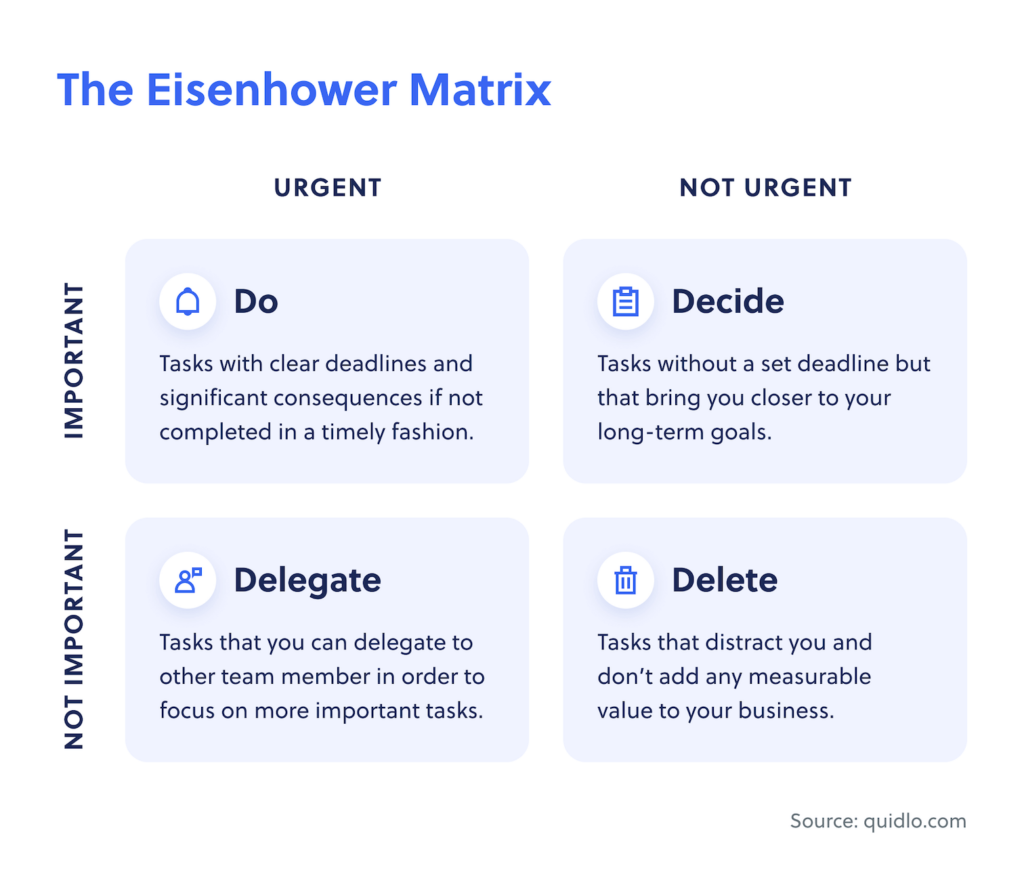We’d be lying if we said time management is an easy task. Whether it’s about your professional life or personal life, you always have too many responsibilities and tasks to do and too little time.
That’s the truth for most people, with reports suggesting that up to 82% of people do not manage their time effectively.
Fortunately, Stephen Covey came up with a time management matrix that helps us manage our daily tasks and priorities better. This matrix consists of four quadrants that divide tasks according to their level of importance and urgency.
Prioritizing tasks based on criteria like importance, urgency, and necessity leads us to become more productive with our time — a crucial ingredient for any successful endeavor.
In this article, let’s take a deeper look at what the Covey Time Management Matrix is, its benefits, how to implement it, and whether it differs from the Eisenhower time management matrix.
A free editable Covey Time Management Matrix is also waiting for you at the end!
Table of Contents
What Is the Covey Time Management Matrix?
The Covey Time Management Matrix is a tool developed by Stephen Covey, author of the best-selling book “Seven Habits of Highly Effective People.” This matrix divides tasks into four quadrants based on their importance and urgency levels.
The four quadrants are:
- Quadrant 1 (Urgent and Important): This quadrant consists of tasks that need immediate action and cannot be avoided. These tasks are usually pressing and require our immediate attention. Examples include handling an urgent client request or meeting, impending deadlines, etc.
- Quadrant 2 (Important but Not Urgent): These are important and critical tasks, but they do not require immediate attention. They should be prioritized so that they can help you reach your long-term goals.
The mistake people usually make is that they don’t give enough attention to this quadrant and instead focus more on urgent tasks. But it’s important to realize that these tasks are the ones that can bring the most value to your business/life.
Examples of tasks in quadrant 2 include strategic planning, spending time with family, exercising, networking with people, any personal development goal, etc.
- Quadrant 3 (Urgent but Not Important): These tasks require immediate attention, but they are not critical in the grand scheme of things. These are usually tasks that can be delegated to someone else for completion. An example of tasks in this quadrant includes answering phone calls or emails that do not bring tangible value to your life.
- Quadrant 4 (Neither Urgent nor Important): These tasks should be avoided at all costs, as they are a complete waste of time and energy. There are a million things that can end up in this quadrant, like watching TV shows, playing video games, browsing aimlessly on the internet, etc.
You now have a top-level understanding of what the Covey Time management Matrix is and how it works. Let’s discuss the benefits to show you why you should use it.
Benefits of the Covey Time Management Matrix
The time management matrix by Stephen Covey provides a simple and effective way to prioritize tasks and allows for proper time management.
Here are some of the benefits it offers:
- Increases productivity: By prioritizing tasks according to importance and urgency, the matrix helps us become more productive with our time. It allows us to focus on the tasks that are important and urgent while delegating the ones that are not to someone else. On a side note, here are other time management techniques you can use to increase your productivity.
- Makes your life less stressful: By helping you identify the key tasks in your life, it allows you to focus on what’s important instead of constantly worrying about things that don’t really matter in the grand scheme of things.
- Improved planning ability: When you use this matrix, you are effectively “planning” your time, as you know which tasks need to be done and when. This improves your planning ability, which can be incredibly useful in all aspects of life.
- Creates a better work-life balance: The time saved by being more productive at work can be used to spend more time with family and friends, which is incredibly important for your mental health and well-being. This has a double benefit too. As your mental health and overall well-being improve, you’ll also witness increased productivity at work.
- Lets you filter out your habits: By looking at your tasks in this matrix and evaluating your performance over time, you can easily identify which habits are beneficial and which ones should be avoided. For example, if you find that most of your activities are in quadrant 4, this indicates a need for change. That helps you in developing better habits and improving your life.
- Helps you achieve your long-term goals: By letting you focus on the tasks that bring value to your life and help you reach your long-term goals, the matrix will help you get there faster. Without this matrix, you might not be able to beat procrastination and may end up delaying your goals (which are important but not urgent).
How to Implement the Covey Time Management Matrix
Now that you’re aware of the Covey Time Management Matrix and its benefits, let’s look at how you can start implementing it in your daily life.
Step 1: List Out Your Tasks
The first step is to list out all the tasks you need to do. This should include both urgent and important tasks as well as those that are not very pressing. This will give you a birds-eye view of all that needs to be done.
Don’t forget to add the deadlines, too. This will help you prioritize your tasks later.
Step 2: Prioritize Your Tasks
Once you have a list of all your tasks, it’s time to prioritize them according to their urgency and importance.
One way you can go about this is by first identifying the most urgent tasks on your list. These should be the ones that are due soon and can’t be missed.
Next, identify tasks that are really important. This includes tasks that can help you progress toward your long-term goals.
Once you have identified both these types of tasks, start assigning them to their respective quadrants on the matrix.
Step 3: Execute Your Tasks Accordingly
Now that you have identified the most important and urgent tasks, it’s time to start executing them.
Start by tackling the most important and urgent tasks first. These should be completed as soon as possible.
Once you have completed these tasks, it’s time to tackle the important but not urgent tasks. These should be given the same level of attention, as they are important for your overall success in life.
Finally, try to avoid the tasks that fall under Quadrant 4. These are a complete waste of time!
Step 3: Re-Evaluate
After a few weeks, it’s vital to re-evaluate your tasks using these productivity metrics and determine how completing tasks in this matrix has improved your personal productivity.
If you find that the system is working for you and helping you reach your goals, stick with it.
If you find that there are tasks that need to be moved to a different quadrant, do so. This will ensure that you are focusing on the tasks that really matter and ignoring those that don’t.
For example, you might’ve initially thought that a particular task was really important, but after a few weeks, you came to realize that it is just not as important. There’s no harm in re-assigning it to the appropriate quadrant in the Covey matrix.
You should also evaluate your progress — did you complete all the tasks on time? If not, why not? This will help you identify any areas of improvement that you can work on in the future.
Remember, the key to success with this system is being honest and realistic about what you can achieve.
Covey Time Management Matrix Example
For a better understanding, here is an example of what the Covey Time Management Matrix can look like for the CEO of a firm.
In the first quadrant, you have tasks that are important and urgent. For example, processing an urgent client order in a timely manner is both an important and an urgent task for a CEO. These are to be done as the first priority.
In the second quadrant, you have tasks that are important but not urgent. For example, strategizing and planning for a new product launch or expansion of services can be important tasks without any time limit attached to them. These tasks often get ignored for the moment and pushed back due to a lack of urgency, but attending to them is essential for the long-term success of a firm.
The third quadrant of this matrix includes replying to emails and choosing a venue for an executive dinner. These are urgent but not important. That’s why these tasks should be done in the least amount of time possible. If possible, it’s best to delegate them to someone else. For example, a CEO can ask their secretary to arrange the venue for an executive dinner.
Finally, the fourth quadrant has tasks that are neither urgent nor important, such as reading correspondence.
Covey Time Management Matrix vs. Eisenhower Time Management Matrix
The Eisenhower Time Management Matrix was popularized by President Dwight Eisenhower and is based on the principle of decision-making. This matrix also categorizes tasks according to their level of importance and urgency.

Similar to the Covey Time Management Matrix, it has four quadrants — important but not urgent, important and urgent, not important but urgent, and not important and not urgent.
Both Covey and Eisenhower’s time management matrices are based on the same premise — to help you identify the most important tasks and tackle them first.
The only small difference between the two matrices is that the four quadrants of the Eisenhower Time Management Matrix are usually labeled as ‘Do,’ ‘Decide,’ ‘Delegate,’ and ‘Delete.’ On the other hand, Covey’s Time Management Matrix has no label for its four quadrants.
Covey Time Management Matrix Template
Several templates are available online if you want to get started with the Covey Time Management Matrix. You can use these templates to set up your own matrix and assign tasks to the respective quadrants.
You can find a PDF version of the template below here. In addition, templates made for PowerPoint are available on this site.
We also have some additional Excel time-tracking templates and some Google Sheets time tracking templates that you might find helpful.
What Not to Do When Using Covey Time Management Matrix
It’s important to remember that the Covey Time Management Matrix is not a magic bullet or a one-size-fits-all solution. It can take some time and practice to use it effectively. To increase your chances of success, we’ve compiled some tips on what to do and avoid when following the covey time management matrix.
So, here are some tips on what not to do when using this matrix:
- Don’t try to manage or do too many tasks all at once. Breaking down your tasks into manageable chunks can help you stay organized and focused.
- Don’t be overly rigid or inflexible with deadlines and priorities. Sometimes, there may be a need to change a task’s position in the matrix if it turns out it’s not so urgent or important anymore.
- Don’t forget to take breaks and rest when needed. This will help you stay energized and focused on the tasks at hand.
- Don’t overfill your quadrants. You don’t need to put all the tasks in the matrix. Instead, prioritize and focus on the major tasks first. Poor planning and overfilling quadrants with minute tasks will make it difficult to focus on the important work. It can also be very intimidating, which may hurt your productivity.
- Don’t forget to ask for help when needed. Delegating tasks will help you stay productive and get more done in less time.
- Don’t forget to review your matrix periodically. This will help you keep track of your progress and make adjustments when needed.
- Don’t set unrealistic goals and expectations. This goes for all the time management strategies out there because setting unrealistic goals only leads to frustration and burnout.
Get Productive with Covey’s Time Management Matrix
The Covey Time Management Matrix is an effective way to organize your tasks, prioritize them, and ultimately become more productive. By breaking down the tasks into four quadrants, you can focus on those that are most important and ignore those that are not.
Also, remember to evaluate your progress and adjust your matrix accordingly. As long as you stay honest and realistic about what you can achieve, you will be able to reap the benefits of using this time management tool.
So, why not give Stephen Covey’s Matrix a try today? You have nothing to lose and everything to gain. Here’s to your increased productivity!







